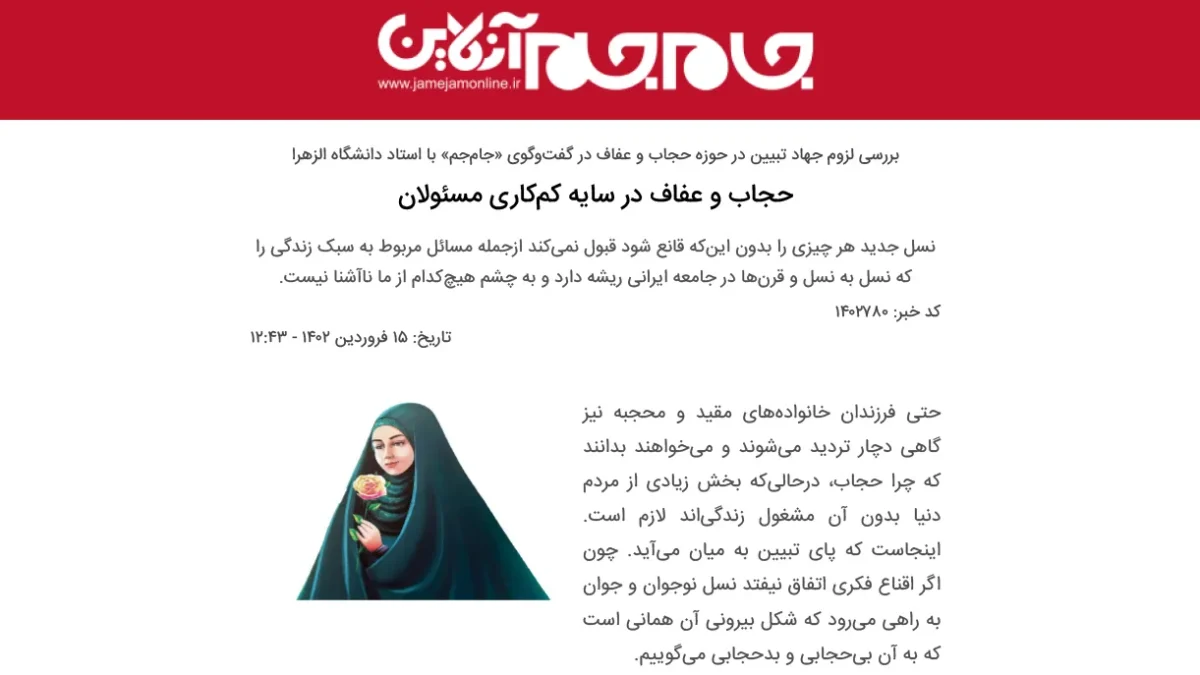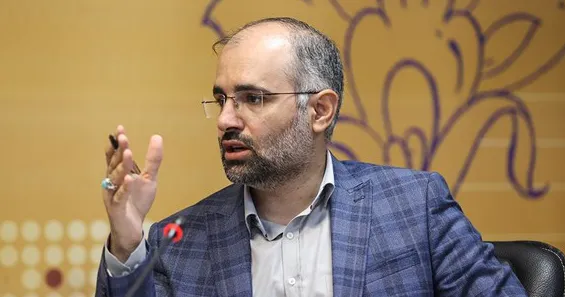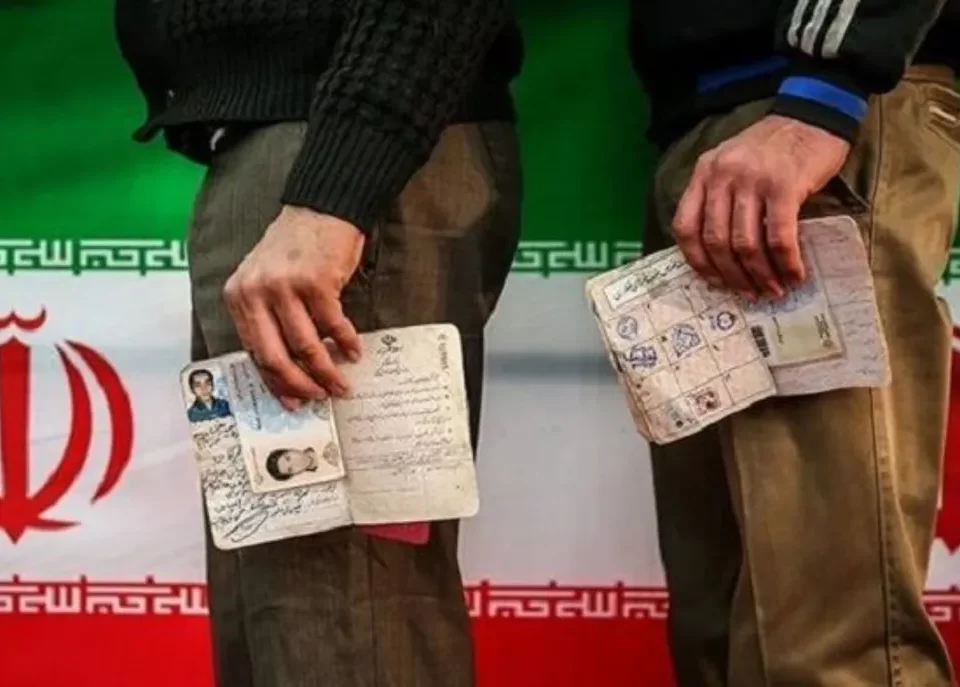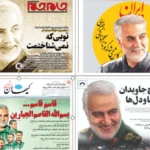
Media review; Qassem Soleimani is the headline of newspapers; Money or force?
May 7, 2023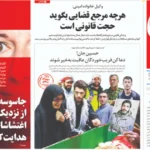
Media Review: Javan Newspaper and the Reproduction of “Suppression Stereotype” by the Government
May 7, 2023The Jomjom reporter asks, “What is evident from field observations is the increasing trend of unveiledness in the country. In your opinion, why has our society reached this point?”
One of the common methods used by the media to gather information is through interviews. Journalists usually resort to interviews to obtain information and analyze news and social issues. Therefore, it can be said that most media narratives and reports are based on interviews.
An interview can be news-oriented, analytical, telephone-based, informal, personal, etc. Each interview has its own characteristics and requirements. For example, a news interview is short, direct, without prior coordination or preparation, and happens instantly. On the other hand, an analytical interview requires preliminary research, planning, prior coordination, and a calm and stress-free environment. In an analytical interview, both the interviewer and the interviewee need preparation and intellectual coherence to convey accurate and error-free information to the audience.
An interview should not necessarily be challenging. Conversely, using the interviewee to confirm one’s own opinions and convey a biased line of thought to the audience is more than just media work; it is propaganda.
To clarify the issue, watch the Jomjom reporter’s interview with Dr. Leila Sameni, a faculty member at Alzahra University, titled “Hijab and Chastity in the Shadow of Officials’ Inaction” on April 4, 2023. In this interview, the Jomjom reporter prepares the questions and interview responses and prompts the interviewee for their repetition.
In the introduction, she says, “…if intellectual persuasion does not occur, the younger generation will follow a path that outwardly manifests as what we call unveiledness and immodesty.”
Then, with this introduction, the interview proceeds, and she asks, “What is evident from field observations is the increasing trend of unveiledness in the country. In your opinion, why has our society reached this point?”
And she hears the response, “The trend of immodesty, which used to progress slowly in the form of heavy makeup or loose veils, is now emerging and progressing more rapidly. In other words, although in recent months, especially after the disturbances, a larger number of women in society weakened their hijab due to the weakened enforcement of addressing immodesty and unveiledness, it is not the case to say that the entire society or most individuals have been involved… Scientific studies have also shown a direct relationship between the state of hijab and the level of sexual violence against women, and the higher the discovery rate of hijab, the higher the statistics of physical, verbal, and behavioral violence. Therefore, if our women seek security and tranquility, they must also preserve the security of society with appropriate clothing.”
The Jomjom reporter immediately asks the second question and says, “Undoubtedly, one of the reasons that has brought the situation of hijab and chastity in our society to its current state is the weakness of cultural institutions. In your opinion, how have cultural deficiencies facilitated immodesty in the country, and what is the most significant weakness in this area?”
Leyla Samani also responds in the following manner: “I believe the most significant weakness of cultural institutions in our country is the lack of clarification regarding the issue of hijab. A woman who understands the positive impact her hijab has on the formation and strengthening of the family, the upbringing of children, and the health and safety of the work and social environment will certainly observe the hijab. However, this clarification has not taken place for years, and the philosophy of hijab has not been expressed as needed. We rarely hear statements at the public level that talk about the benefits of hijab or the harms of the absence of hijab in Western societies and our own society. The necessity of observing hijab and modesty is so rational and logical that it only requires good discussion about it and the explanation of the benefits of observing the etiquette of dress and modesty in speech, behavior, gaze, and attire. But our cultural institutions have not done such things.”
This interview is noteworthy from several angles:
1. Production of false information
The interviewee in this conversation presents baseless claims and is not questioned by the Jam-e-Jam reporter. Both the questions and answers are biased and in line with promoting the official policy of the Islamic Republic system, rather than increasing the audience’s awareness. The interviewee claims:
Scientific studies have also proven that the state of hijab has a direct relationship with the level of sexual violence against women, and as the statistics of hijab discovery increase, the statistics of physical, verbal, and behavioral violence also increase. Therefore, if our women are seeking security and peace, they should also preserve the security of society with appropriate clothing. We rarely hear statements at the public level that talk about the benefits of hijab or the harms of the absence of hijab in Western societies and our own society. The necessity of observing hijab and modesty is so rational and logical that it only requires good discussion about it. If we set aside malicious individuals, other people also consider hijab as a rational discussion that is necessary for effective social presence and the growth of talents. Neither does the interviewee state the source of their information nor does the interviewer ask them about it. Because “facts” and “the credibility of the claims” are not a propaganda issue. The important thing for propaganda is to promote its own ideological line in a way that influences the audience. In fact, distorting public opinion is the goal, not raising awareness.
2. Production of Fake Stereotypes
The interviewee states, “We rarely hear statements at the public level that talk about the benefits of hijab or the harms of the absence of hijab in Western societies and our own society.” Introducing the West as a symbol of immodesty is a completely fake stereotype because hijab exists outside the Islamic world (even in some Islamic societies) and is also practiced by a minority among Jews. It means that immodesty is as prevalent in China, Korea, and Indonesia as it is in America, England, and France. Referring the audience’s minds to the West when discussing a concept like immodesty promotes a fabricated stereotype to promote anti-Western propaganda. For this reason, promoters of the impositional policies of the Islamic Republic think that they can justify their policies with such fake stereotypes.
3. Violation of the Principle of Neutrality
Media outlets are obliged to adhere to the principle of neutrality and refrain from taking sides in the production and dissemination of information. For this reason, independent media outlets usually strive to include multiple voices and involve a larger number of opinion holders in the discussion when analyzing topics that have supporters and opponents in society, so that all voices are heard. Single-voiced interviews in such topics are not only unprofessional but also undermine media credibility.
What leads to the publication of such interviews as produced content in domestic media stems from a reality, which is that these media outlets are not independent but rather advertising companies affiliated with the government that also funds them. Therefore, having a professional and ethical function for them is irrelevant. Their job is to promote and impose government policies and divert public opinion. These are recognized as harmful media outlets, and protecting oneself and others from them is a requirement of reason.
مرور رسانهها؛ جام جم و تحمیل تک صدایی با اطلاعات و کلیشههای جعلی
یکی از شیوهها یا روشهای معمول در رسانهها برای گردآوری اطلاعات، مصاحبه/گفتوگو است. معمولا خبرنگاران برای دریافت اطلاعات و تحلیل اخبار و مسایل جامعه، به مصاحبه متوسل میشوند. به همین دلیل میتوان گفت اکثر روایتها و گزارشهای رسانهای بر پایه گفتوگو استوار است.
گفتوگو میتواند خبری، تحلیلی، تلفنی، غیررسمی، شخصی و… باشد. هر مصاحبه هم مشخصات و الزامات خاص خود را دارد؛ برای مثال، مصاحبه خبری، کوتاه، مستقیم، بدون هماهنگی یا مطالعه قبلی و به صورت آنی اتفاق میافتد ولی یک مصاحبه تحلیلی نیاز به تحقیقات مقدماتی، طراحی، هماهنگی قبلی و محیطی آرام و بدون استرس دارد. در مصاحبه تحلیلی، هم مصاحبهکننده و هم مصاحبهشونده نیاز به آمادهسازی و انسجام فکری دارند تا اطلاعات دقیق و بدون خطا به مخاطب منتقل کنند.
مصاحبه الزاما نباید چالشی باشد. در نقطه مقابل، استفاده از مصاحبه شونده برای تایید نظرات خود و انتقال یک خط فکری جهتدار به مخاطب نیز بیش از آن که کار رسانهای باشد، رسم پروپاگاندا است.
***
برای روشن شدن مساله، مصاحبه خبرنگار «جامجم» با دکتر «لیلا ثمنی»، عضو هیاتعلمی «دانشگاه الزهرا» که روز ۱۵ فروردین ۱۴۰۲ با عنوان «حجاب و عفاف در سایه کمکاری مسوولان» را ببینید. در این مصاحبه، خبرنگار جامجم سوالها و جوابهای مصاحبه را آماده دارد و مصاحبه شونده را به تکرار آن وا میدارد.
او در مقدمه میگوید: «…اگر اقناع فکری اتفاق نیفتد، نسل نوجوان و جوان به راهی میرود که شکل بیرونی آن همانی است که به آن بیحجابی و بدحجابی میگوییم.»
سپس با این مقدمه وارد مصاحبه میشود و میپرسد: «آنچه از مشاهدات میدانی پیدا است، گویای روند فزاینده بدحجابی در کشور است. به نظر شما چرا جامعه ما به این نقطه رسیده است؟»
و در جواب میشنود: «روند بدحجابی که قبلا بهصورت آرایشهای غلیظ یا حجابهای سست با حرکتی کند در حال پیشرفت بود، اکنون با حرکتی تندتر در حال بروز و ظهور است. به عبارت دیگر، گرچه در ماههای اخیر و بهخصوص بعد از اغتشاشات به این علت که روند رسیدگی به بدحجابی و بیحجابی ضعیف شد، تعداد بیشتری از بانوان جامعه حجابشان را ضعیف کردند ولی اینطور نیست که بگوییم همه جامعه یا اکثر قریب به اتفاق افراد درگیر شدهاند. …مطالعات علمی نیز ثابت کرده که وضعیت حجاب با میزان خشونت جنسی علیه زنان رابطه مستقیم دارد و هر قدر آمار کشف حجاب بالا برود، آمار خشونتهای جسمی، کلامی و رفتاری نیز افزایش مییابد. بنابراین اگر زنان ما دنبال امنیت و آرامش هستند، باید با پوشش مناسب خود، امنیت جامعه را نیز حفظ کنند.»
خبرنگار جامجم بلافاصله سوال دوم را مطرح میکند و میپرسد: «بیشک یکی از دلایلی که وضعیت حجاب و عفاف در جامعه ما را به نقطه کنونی رسانده، ضعف نهادهای فرهنگی بوده است. به نظر شما کمکاریهای فرهنگی چهطور بستر بدحجابی در کشور را مهیا کرده و مهمترین ضعف در این حوزه چیست؟»
لیلا ثمنی نیز این گونه پاسخ میدهد: «معتقدم مهمترین ضعف نهادهای فرهنگی در کشورمان، عدم تبیین مساله حجاب است. زنی که بداند حجاب او چه تاثیر مثبتی بر تشکیل و تحکیم خانواده، تربیت فرزندان و سلامت و امنیت محیط کار و اجتماع دارد، قطعا حجاب را رعایت میکند. اما این تبیین سالها است که صورت نگرفته و فلسفه حجاب آنطور که نیاز بوده، بیان نشده است. ما کمتر جملاتی را در سطح عمومی میشنویم که درباره فواید حجاب یا درباره آسیبهای نبود حجاب در جوامع غربی و جامعه خودمان صحبت کند. ضرورت رعایت حجاب و عفاف به قدری عقلانی و منطقی است که فقط کافی است دربارهاش خوب صحبت شود و درباره فواید رعایت آداب پوشش و رعایت حیا در کلام، رفتار، نگاه و پوشش تبیین صورت گیرد اما نهادهای فرهنگی ما چنین کارهایی را انجام ندادهاند.»
این مصاحبه از چند زاویه قابل توجه است:
۱- تولید اطلاعات جعلی
مصاحبه شونده در این گفتوگو، ادعاهای بیاساس طرح میکند و مورد پرسش خبرنگار جامجم واقع نمیشود. چراکه هم پرسشها و هم پاسخها، جهتدار و در راستای تبلیغ سیاست رسمی نظام جمهوری اسلامی هستند، نه افزایش آگاهی مخاطب. مصاحبهشونده مدعی میشود:
- مطالعات علمی نیز ثابت کرده که وضعیت حجاب با میزان خشونت جنسی علیه زنان رابطه مستقیم دارد و هر قدر آمار کشف حجاب بالا برود آمار خشونتهای جسمی، کلامی و رفتاری نیز افزایش مییابد. بنابراین اگر زنان ما دنبال امنیت و آرامش هستند، باید با پوشش مناسب خود، امنیت جامعه را نیز حفظ کنند.
- ما کمتر جملاتی را در سطح عمومی میشنویم که درباره فواید حجاب یا درباره آسیبهای نبود حجاب در جوامع غربی و جامعه خودمان صحبت کند.
- ضرورت رعایت حجاب و عفاف به قدری عقلانی و منطقی است که فقط کافی است دربارهاش خوب صحبت شود.
- اگر افراد مغرض را کنار بگذاریم، سایر افراد نیز حجاب را بحثی عقلی میدانند که برای حضور اجتماعی موثر و رشد استعدادها ضروری است.
نه مصاحبهشونده میگوید منبع اطلاعاتش کجا است و این تحقیقات کجا انجام شدهاند و نه مصاحبه کننده از او میپرسد. چراکه «فکت» و «مستند بودن ادعاها»، مساله پروپاگاندا نیست. برای پروپاگاندا مهم این است که خط فکری خود را به گونهای جهتدار تبلیغ کند که بر مخاطب اثر بگذارد. در واقع انحراف افکار عمومی هدف است، نه آگاهی بخشی.
۲- تولید کلیشه جعلی
مصاحبه شونده میگوید: «ما کمتر جملاتی را در سطح عمومی میشنویم که درباره فواید حجاب یا درباره آسیبهای نبود حجاب در جوامع غربی و جامعه خودمان صحبت کند.» معرفی غرب به عنوان نماد بیحجابی، یک کلیشه کاملا جعلی است، زیرا حجاب خارج از جهان اسلام (آن هم در برخی جوامع اسلامی) و اقلیتی در میان یهودیان، موضوعیت ندارد؛ یعنی بیحجابی به همان اندازه در چین و کره و اندونزی جاری است که در امریکا و انگلیس و فرانسه. ارجاع ذهن مخاطب به غرب در مواجهه با موضوعی به نام بیحجابی، ترویج کلیشهای جعلی برای چیدن محصول ترویج غربستیزی است. به همین دلیل مروجان سیاستهای تحمیلی جمهوری اسلامی فکر میکنند با چنین کلیشههای جعلی میتوانند سیاستهای خود را موجه نشان دهند.
۳- نقض اصل بیطرفی
رسانهها مکلف به رعایت اصل بیطرفی و پرهیز از جانبداری در تولید و انتقال اطلاعات هستند. به همین دلیل، معمولا رسانههای مستقل در تحلیل موضوعاتی که موافقان و مخالفانی در جامعه دارند، میکوشند چند صدایی را رعایت و موضوع را با مشارکت تعداد بیشتری از صاحبنظران به بحث بگذارند تا همه صداها شنیده شوند. مصاحبه تک صدایی در چنین موضوعاتی نه تنها خلاف اخلاق حرفهای بلکه مخدوش کننده اعتبار رسانهای است.
آنچه سبب میشود چنین مصاحبههایی به عنوان محتوای تولیدی، در رسانههای داخل منتشر شوند، از یک واقعیت نشات میگیرند و آن این که این رسانهها مستقل نیستند بلکه بنگاههای تبلیغاتی وابسته به حکومت هستند که دخل و خرجشان را نیز حکومت تامین میکند. بنابراین داشتن کارکرد حرفهای و اخلاقی برای آنها بلاموضوع است. کار آنها تبلیغ و تحمیل سیاستهای حکومت و به انحراف کشاندن افکار عمومی است؛ رسانههایی که مضر شناخته میشوند و حفاظت از خود و دیگران در برابر آنها شرط عقل است.

